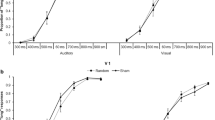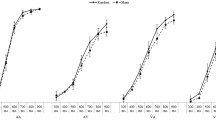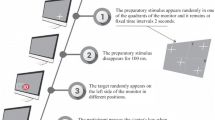Abstract
The low-frequency repetitive transcranial magnetic stimulation (rTMS) application has been associated with changes in cognitive processes embedded during time perception tasks. Although several studies have investigated the influence of neuromodulation on time perception, the effect of the 1-Hz rTMS application on the superior parietal cortex is not clearly understood. This study analyzes the effect of the low-frequency rTMS on time estimation when applied in the parietal medial longitudinal fissure. For the proposed study, 20 subjects were randomly selected for a crossover study with two conditions (sham and 1 Hz). Our findings reveal that participant underestimate 1-s time interval and overestimate 4-s and 9-s time intervals after 1-Hz rTMS (p ≤ 0.05). We conclude that the 1-Hz rTMS in the parietal medial longitudinal fissure delays short interval and speed up long time intervals. This could be due to the effect of parietal inhibition on the attentional level and working memory functions during time estimation.



Similar content being viewed by others
References
Teixeira S, Machado S, Paes F, Velasques B, Silva JG, Sanfim AL, Minc D, Anghinah R, Menegaldo LL, Salama M, Cagy M, Nardi AE, Pöppel E, Bao Y, Szelag E, Ribeiro P, Arias-Carrión O (2013) Time perception distortion in neuropsychiatric and neurological disorders. CNS Neurol Disord Drug Targets 12(5):567–582
Matthews WJ, Meck WH (2014) Time perception: the bad news and the good. WIREs Cogn Sci 5:429–446
Marinho V, Oliveira T, Rocha K, Ribeiro J, Magalhães F, Bento T, Pinto GR, Velasques B, Ribeiro P, Di Giorgio L, Orsini M, Gupta DS, Bittencourt J, Bastos VH, Teixeira S (2018) The dopaminergic system dynamic in the time perception: a review of the evidence. Int J Neurosci 128(3):262–282
Gupta DS (2014) Processing of sub- and supra-second intervals in the primate brain results from the calibration of neuronal oscillators via sensory, motor, and feedback processes. Front Psychol 5:816
Fontes R, Ribeiro J, Gupta DS, Machado D, Lopes-Júnior F, Magalhães F, Bastos VH, Rocha K, Marinho V, Lima G, Velasques B, Ribeiro P, Orsini M, Pessoa B, Leite MA, Teixeira S (2016) Time perception mechanisms at central nervous system. Neurol Int 8(1):5939
Harrington DL, Zimbelman JL, Hinton SC, Rao SM (2010) Neural modulation of temporal encoding, maintenance, and decision processes. Cereb Cortex 20:1274–1285
Merchant H, Harrington DL, Meck WH (2013) Neural basis of the perception and estimation of time. Annu Rev Neurosci 36:313–336
Block RA, Grondin S (2014) Timing and time perception: a selective review and commentary on recent reviews. Front Psychol 5:648
Oliveri M, Koch G, Salerno S, Torriero S, LoGerfo (2009) Caltagirone C. Representation of time intervals in the right posterior parietal cortex: implications for a mental time line. Neuroimage 46:1173–1179
Vicario CM, Martino D, Koch G (2013) Temporal accuracy and variability in the left and right posterior parietal cortex. Neuroscience 245:121–128
Cole MW, Reynolds JR, Power JD, Repovs G, Anticevic A, Braver TS (2013) Multi-task connectivity reveals flexible hubs for adaptive task control. Nat Neurosci 16:1348–1355
Zanto TP, Gazzaley A (2013) Fronto-parietal network: flexible hub of cognitive control. Trends Cogn Sci 17:602–603
Coull JT, Cheng RK, Meck WH (2011) Neuroanatomical and neurochemical substrates of timing. Neuropsychopharmacology. 36(1):3–25
Cook EP, Pack CC (2012) Parietal cortex signals come unstuck in time. PLoS Biol 10:e1001414
Jones CRG, Malone TJL, Dirnberger G, Edwards M, Jahanshahi M (2008) Basal ganglia, dopamine and temporal processing: performance on three timing tasks on and off medication in Parkinson’s disease. Brain Cogn 68:30–41
Bueti D, Walsh V, Frith C, Rees G (2009) Different brain circuits underlie motor and perceptual representations of temporal intervals. J Cogn Neurosci 20(2):204–214
Barzman D, Geise C, Lin P (2015) Review of the genetic basis of emotion dysregulation in children and adolescents. World J Psychiatry 5(1):112–117
Livesey AC, Wall MB, Smith AT (2007) Time perception: manipulation of task difficulty dissociates clock functions from other cognitive demands. Neuropsychologia. 45(2):321–331
Macar F, Vidal F (2009) Timing processes: an outline of behavioural and neural indices not systematically considered in timing models. Can J Exp Psychol 63(3):227–239
Koenigs M, Barbey AK, Postle BR, Grafman J (2009) Superior parietal cortex is critical for the manipulation of information in working memory. J Neurosci 29(47):14980–14986
Gongora M, Bittencourt J, Teixeira S, Basile LF, Pompeu F, Droguett EL, Arias-Carrion O, Budde H, Cagy M, Velasques B, Nardi AE, Ribeiro P (2016) Low-frequency rTMS over the Parieto-frontal network during a sensorimotor task: the role of absolute beta power in the sensorimotor integration. Neurosci Lett 12(611):1–5
Oldfield RC (1971) The assessment and analysis of handedness: the Edinburgh inventory. Neuropsychologia. 9(1):97–113
Rossi S, Hallett M, Rossini PM, Pascual-Leone A (2011) Screening questionnaire before TMS: an update. Clin Neurophysiol 122(8):1686
Wittmann M (2013) The inner sense of time: how the brain creates a representation of duration. Nat Rev Neurosci 14:217–223
Jozefowiez J, Polack CW, Machado A, Miller RR (2014) Trial frequency effects in human temporal bisection: implications for theories of timing. Behav Process 101:81–88
Brown SW (1985) Time perception and attention: the effects of prospective versus retrospective paradigms and task demands on perceived duration. Percept Psychophys 38:115–124
Mioni G, Stablum F, Mcclintock SM, Grondin S (2014) Different methods for reproducing time, different results. Atten Percept Psychophysiol 76:675–681
Najib U, Bashir S, Edwards D, Rotenberg A, Pascual-Leone A (2011) Transcranial brain stimulation: clinical applications and future directions. Neurosurg Clin N Am 22(2):233–251
Rossi S, Hallett M, Rossini PM, Pascual-Leone A, Safety OF (2009) Safety, ethical considerations, and application guidelines for the use of transcranial magnetic stimulation in clinical practice and research. Clin Neurophysiol 120:2008–2039
Sato A, Torii T, Nakahara Y, Iwahashi M, Itoh Y, Iramina K (2013) The impact of rTMS over the dorsolateral prefrontal cortex on cognitive processing. ConfProc IEEE Eng Med Biol Soc:1988–1991
Ribeiro JA, Marinho FVC, Rocha K, Magalhães F, Baptista AF, Velasques B, Ribeiro P, Cagy M, Bastos VH, Gupta D, Teixeira S (2018) Low-frequency rTMS in the superior parietal cortex affects the working memory in horizontal axis during the spatial task performance. Neurol Sci 39(3):527–532
Herwig U, Satrapi P, Schönfeldt-Lecuona C (2003) Using the international 10-20 EEG system for positioning of transcranial magnetic stimulation. Brain Topogr 16(2):95–99
Kehrer S, Kraft A, Koch SP, Kathmann N, Irlbacher K, Brandt SA (2015) Timing of spatial priming within the fronto-parietal attention network: a TMS study. Neuropsychologia. 74:30–36
Vandenberghe R, Gitelman DR, Parrish TB, Mesulam MM (2001) Location- or feature-based targeting of peripheral attention. Neuroimage. 14(1 Pt 1):37–47
Oliveira FT, Diedrichsen J, Verstynen T, Duque J, Ivry RB (2010) Transcranial magnetic stimulation of posterior parietal cortex affects decisions of hand choice. Proc Natl Acad Sci U S A 107(41):17751–17756
Duecker F, Sack AT (2015) Rethinking the role of sham TMS. Front Psychol 6:210
Hopkins WG, Marshall SW, Batterham AM, Hanin J (2009) Progressive statistics for studies in sports medicine and exercise science. Med Sci Sports Exerc 41(1):3–13
Fayers PM, Machin D (1995) Sample size: how many patients are necessary? Br J Cancer 72:1–9
Droit-Volet S (2013) Time perception, emotions and mood disorders. J Physiol Paris 107:255–264
Lake JI, Meck WH (2013) Differential effects of amphetamine and haloperidol on temporal reproduction: dopaminergic regulation of attention and clock speed. Neuropsychologia 51(2):284–292
Droit-Volet S, Gil S (2016) The emotional body and time perception. Cognit Emot 30(4):687–699
French RM, Addyman C, Mareschal D, Thomas E (2014) Unifying Prospective and Retrospective interval-time estimation: a fading-gaussian activation-based model of interval-timing. Procedia Soc Behav Sci 126(21):141–150
Coull JT, Vidal F, Nazarian B et al (2004) Functional anatomy of the attentional modulation of time estimation. Science 5:1506–1508
Ivry RB, Spencer RM (2004) The neural representation of time. Curr Opin Neurobiol 14(2):225–232
Jones CR, Rosenkranz K, Rothwell JC, Jahanshahi M (2004) The right dorsolateral prefrontal cortex is essential in time reproduction: an investigation with repetitive transcranial magnetic stimulation. Exp Brain Res 158:366–372
Grondin S (2010) Timing and time perception: a review of recent behavioral and neuroscience findings and theoretical directions. AP&P 72(3):561–582
Droit-Volet S, Meck WH (2007) How emotions colour our perception of time. Trends Cogn Sci 11(12):504–513
Wittmann M (2009) The inner experience of time. Philos Trans R Soc B 364:1955–1967
Fiorillo CD, Newsome WT, Schultz W (2008) The temporal precision of reward prediction in dopamine neurons. Nat Neurosci 11(8):966–973
Koch G, Oliveri M, Caltagirone C (2009) Neural networks engaged in milliseconds and seconds time processing: evidence from transcranial magnetic stimulation and patients with cortical or subcortical dysfunction. Philos Trans R Soc Lond Ser B Biol Sci 364:1907–1918
Carvalho FM, Chaim KT, Sanchez TA, Araujo DB (2016) Time-Perception Network and Default mode network are associated with temporal prediction in a periodic motion task. Front Hum Neurosci 10:268
Alonso-Valerdi LM, Sepulveda F, Ramírez-Mendoza RA (2015) Perception and Cognition of cues used in synchronous brain–computer interfaces modify electroencephalographic patterns of control tasks. Front Hum Neurosci 9:636
Karaminis T, Cicchini GM, Neil L, Cappagli G, Aagten-Murphy D, Burr D, Pellicano E (2016) Central tendency effects in time interval reproduction in autism. Sci Rep 6:28570
Murai Y, Yotsumoto Y (2016) Time scale- and sensory modality-dependency of the central tendency of time perception. PLoS One 11:e0158921
Righi S, Galli L, Paganini M, Bertini L, Viggiano MP, Piacentini S (2016; Jan) Time perception impairment in early-to-moderate stages of Huntington’s disease is related to memory deficits. Neurol Sci 37(1):97–104
Gibbon J (1977) Scalar expectancy theory and Weber’s law in animal timing. Psychol Rev 84:279–325
Lewis PA, Miall RC (2009) The precision of temporal judgement: milliseconds, many minutes, and beyond. Philos Trans R Soc Lond Ser B Biol Sci 364(1525):1897–1905
Gruber RP, Block RA (2013) The flow of time as a perceptual illusion. J Mind Behav 34:91–100
Buhusi CV, Meck WH (2009) Relativity Theory and Time perception: single or multiple clocks? PLoS One 4(7):e6268
Bonato M, Zorzi M, Umiltà C (2012) When time is space: evidence for a mental time line. Neurosci Biobehav Rev 36(10):2257–2273
Ogden RS, Moore D, Redfern L, McGlone F (2014) The effect of pain and the anticipation of pain on temporal perception: a role for attention and arousal. Cognit Emot 29(5):910–922
Albrecht DS, Kareken DA, Christian BT, Dzemidzic M, Yoder KK (2014) Cortical dopamine release during a behavioral response inhibition task. Synapse. 68(6):266–274
Strafella AP, Ko JH, Monchi O (2006) Therapeutic application of transcranial magnetic stimulation in Parkinson’s disease: the contribution of expectation. NeuroImage 31(4):1666–1672
Treister R, Lang M, Klein MM, Oaklander AL (2013) Non-invasive transcranial magnetic stimulation (TMS) of the motor cortex for neuropathic pain—at the tipping point? Rambam Maimonides Med J 4(4):e0023
Acknowledgments
The authors would like to acknowledge Brazil’s National Council for Scientific and Technological Development (CNPq) for supporting this study.
Conflict of interest
The authors declare that they have no conflict of interest.
Author information
Authors and Affiliations
Corresponding author
Ethics declarations
The ethics committee of the Federal University of Rio de Janeiro approved the protocol for the study (no. 520.189).
Additional information
Publisher’s note
Springer Nature remains neutral with regard to jurisdictional claims in published maps and institutional affiliations.
Rights and permissions
About this article
Cite this article
Manaia, F., Rocha, K., Marinho, V. et al. The role of low-frequency rTMS in the superior parietal cortex during time estimation. Neurol Sci 40, 1183–1189 (2019). https://doi.org/10.1007/s10072-019-03820-8
Received:
Accepted:
Published:
Issue Date:
DOI: https://doi.org/10.1007/s10072-019-03820-8




